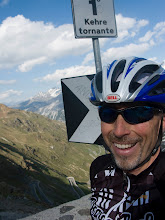
Warning – this post may only be interesting to people in the ski biz – and maybe not all of them.
Doug Allen told me that ski lifts in Europe were more exotic than we commonly see in the U.S.. My tramp around Zermatt today was my first opportunity to see for myself.

Before getting to the lifts, the ticketing process was an interesting deviation from the U.S. model as well. They used the Ski Data point of sale and access control systems, and there is no way they could sell their products the way they do without it. Take the side of the mountain where I wanted to ascend as an example. The lift ticket had 3 different prices depending on whether you wanted to go 1/3 of the way up, 2/3 or all the way to the top. There were then 3 more price points if you wanted to ride the lift back down. Before you even start talking about discounting, packaging, kids, multi-days, etc., there were 6 prices you could pay to get on the lift just once. I was a little surprised to see that they not only had turnstile access to get on the first lift, they also had turnstiles to exit the lift at the top of #2 (and I assume #3). I could not figure out how they would handle exceptions for exit controls, but it certainly keeps everyone honest and accounted for. They did not prevent anyone from getting on lift #2, which I thought was a control gap, but they validated that you had paid for the 2nd segment of the ride when you got off at the top. They must have had some method to collect from unpaid riders at the top of each lift.
Unlike most U.S. ski resorts, Zermatt has a significant portion of their lift system running during the summer to provide hiking and biking access to their extensive trail network and the back country. They were operating 12 lifts, including gondolas, trams, a funicular, a cog railway train and something I don’t even know what to call (like an elevator that operates on a diagonal rather than vertical path). 4 of them service glacier skiing at the top year-round.
The summer access prices were very high - like everything in Switzerland. A ride on one of the small base area lifts could be as little as 10 CHF (Swiss Francs ~$.90). A single ride from bottom to top of the mountain can be as much as 58 and if you want to ride back down, the total cost is 90. Every lift has a separate price, but those are the extremes. A 3-day hiking pass that gives you access to everything is 183. Those prices make U.S. lift ticket prices seem like a huge bargain. For a little more than the cost of a single lift ride at Zermatt, you can ski all day at Steamboat. Skiing is just an amenity to enhance the experience of riding the lift.
Now – on to those exotic lifts. Here is the experience I had getting to the top of the second lift for today’s hike.
1) I purchased the ticket

2) I walked through a tunnel to get to the first lift. I don’t mean a hallway, I mean a 500 foot tunnel deep inside the mountain. Think capital spending like a large-scale mine.

3) Electronic status signs indicated the departure time for the next lift, which was a funicular (inclined railway).
4) The train arrived at the bottom station on what appeared to be a 35-40 degree angle. There did not seem to be any means of articulation in the train, so I believe the track maintained that exact pitch from bottom to top. The entire ride was underground, obviously engineered so that the grade from the starting point deep inside the mountain was exactly what was needed to reach to surface at the top station. The evac plan was apparently to use an 18" wide stair case that ran from bottom to top along the track. I would guess there were more than 1,000 stairs. Wouldn't that be fun in ski boots?

5) When we arrived at the top, the doors opened and I walked the final steps back into the sunlight.

6) This was a typical mid-way station like many ski mountains (except most mountains don’t have a view of the Matterhorn). It had a lodge with a dining room and a bike terrain park. It also had a smaller tunnel that lead to the diagonal elevator. You pressed a button to call for a car and a gondola-like cabin arrived on either of two tracks. When you entered, you pressed another button (like an elevator) and the cabin descended on the track to the lower terminal, perhaps 100 vertical feet below. This was obviously a low-capacity lift designed for limited use, but it solved the problem of a short steep pitch providing access to beginner terrain.

7) The next lift was a Doppelmayr gondola. Very familiar.

8) At the top of the gondola, you could either board the final lift or take a pair of high capacity elevators up two floors to exit building. Not that big a deal until you think of the cost of moving that many people efficiently.

9) The final lift was a 100-person tram that went the rest of the way to the top. I did not ride the final leg.
So to recap – For one of three major summer routes up the mountain, you take a funicular to a diagonal elevator to a gondola and a tram. There are other routes that use a surface cog railway, other trams and gondola as well as glacier-mounted chairlifts. In terms of investing in lift capacity, this place spends money like a Vegas casino in 2006 (does anyone remember those days?).




No comments:
Post a Comment